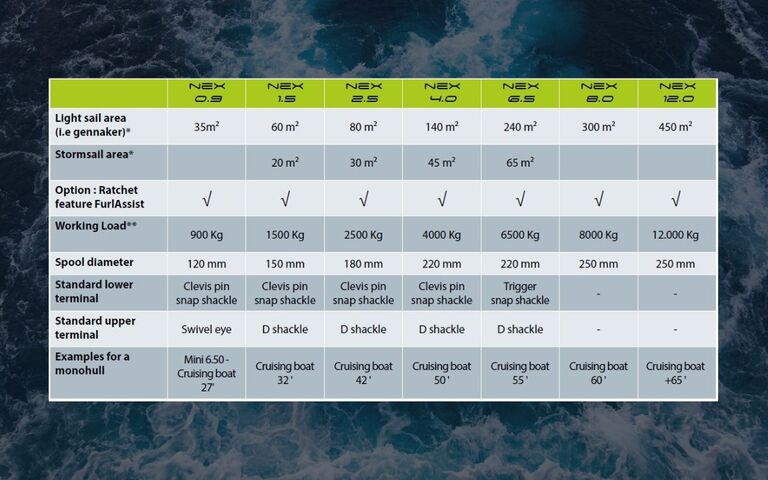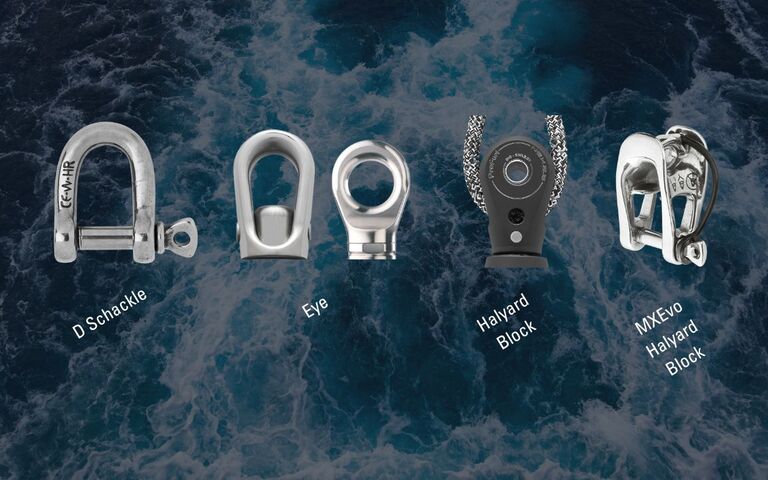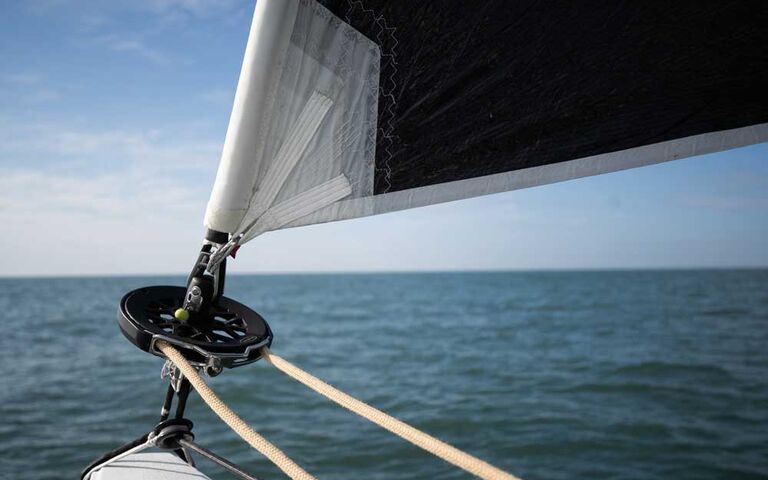Profurl Sail furler : choosing the right terminals
The use of flying sail furlers has become increasingly widespread in recent years. They significantly enhance a sailboat's performance and make sail handling easier. Whether for cruising, racing-cruising, regattas, or offshore racing, choosing the right terminals for your Profurl flying sail furler is essential.
What is a flying sail furler terminal? Why is it important to select the right terminals for your Profurl equipment? What are the different models, and how do you choose the most suitable parts? Our team explains everything in this article.
What is a flying sail furler, and what makes the termination important ?
First, let’s review what a "flying sail furler" is. A flying sail furler is a piece of deck hardware designed to furl a free-flying sail: a light sail such as a gennaker, a Code Zero, or a light genoa, or a heavy-weather sail such as a solent or a staysail. Typically, the furler is installed by the crew each time they wish to use the sail and is then removed and stowed after use. It operates on an "all or nothing" basis: unlike a headsail furling system, it does not allow for partial furling.
Profurl offers seven models of flying sail furlers for sails ranging from 35m² to 450m².
Discover our range of flying sail furlers

Did you know?
Among all the flying sail furlers available on the market, Profurl flying sail furlers are the only ones equipped with 100C6 carbon steel bearings. Due to the hardness and strength of these bearings, furling under heavy loads is a smooth manoeuvre with no bearing deformation. The bearing races are assembled in a sealed grease bath, protecting the entire mechanism from external elements and requiring no maintenance.
As the primary attachment points for the furling system, selecting the correct flying sail furler terminals for your intentions is an important decision that can impact the system performance. The upper terminal connects the halyard to the top swivel, while the lower terminal connects the drum to the attachment point on the deck. There are many types of flying sail furler terminals, each offering different advantages, including D shackles, block shackles, eyes, standard or quick-release snap shackles, blocks, and friction rings.
Flying Sail Furler Termination Options
Profurl furler terminals have been primarily developed in collaboration with Wichard, a specialist in deck hardware manufacturing. This partnership has enriched our catalog with numerous options suited to all sailing needs.

Wichard D Shackle
Forged in high-resistance stainless steel, the Wichard D shackle is available as an upper termination for Profurl flying sail furlers ranging from NEX1.5 to NEX6.5. This universal piece of hardware easily fits the Profurl swivel hub.
The Eye
Specially designed for Profurl flying sail furlers, the eye is available in different models depending on the furler size: for NEX0.9 to NEX8.0, and for NEX12.0. It comes standard with the NEX0.9 and is optional for other models.
Originating from offshore racing, the eye is more compact than the Wichard D shackle, making it ideal for regattas. Its shape prevents rope wear and suits either lashings or splices.
Profurl Halyard Block
Available as an option for flying sail furlers from NEX2.5 to NEX12, the block can be used as an upper or lower termination. It allows for luff tensioning under load to adjust and improve the performance of the sail.
The halyard block requires less physical effort than an eye or D Shackle, easing manoeuvres for crew members. It is an excellent choice for comfortable sailing on larger boats with a reduced crew.
Ball-bearing blocks with aluminum casings are very compact and mount directly onto the swivel or drum. They can also be opened to allow easy installation on a pre-existing halyard.
MXEvo Halyard Block
Manufactured by Wichard, the MXEvo halyard block is an option for Profurl flying sail furlers ranging from NEX0.9 to NEX4.0. It can be used as either an upper or lower termination.
Like the halyard block, the MXEvo halyard block allows for a 2:1 halyard purchase. More compact, it does not include a sheave, eliminating the risk of jamming. This stainless-steel fitting features a captive pin. Compared to a block, the halyard block may introduce more friction, but it will provide extremely high working loads while also reducing weight and requiring no maintenance.

Clevis Pin Snap Shackle
A long-standing Wichard product, the clevis pin snap shackle is a universal piece of hardware available as a standard lower termination for Profurl flying sail furlers from NEX0.9 to NEX4.0.
Mounted to the drum, it adapts to various attachment points such as padeyes, lashings, U-bolts, or eye bolts, to secure the Profurl flying sail furler to the deck.
The clevis pin snap shackle is forged and compact, reducing clutter. It features an ergonomic release ball for easy handling.
For boats with a bowsprit, a fairlead version of the snap shackle includes an arm for guiding the drum to the tip of the bowsprit. This model suits NEX0.9 and NEX1.5 furlers and is available as Profurl reference 54106.
Quick-Release Trigger Snap Shackle
Designed by Wichard for NEX6.5 and NEX8.0 flying sail furlers, the quick-release trigger snap shackle is suitable for sailboats over 55 feet. It is offered as a standard lower termination for the NEX6.5 (Profurl reference 59206) and as an option for the NEX8.0 (Wichard reference 2957).
The piece is designed to be compact, and its quick-opening mechanism allows easy removal of the furler after use.
Solid Sheave
The Solid Sheave terminal is a block with a becket, used to create 2:1 or 3:1 configurations. It is only used as a lower terminal with a drum and is an option for flying sail furlers ranging from NEX1.5 to NEX12.
The Solid Sheave terminal provides the advantage of luff tensioning from below. Its quick-release, captive pin allows for easy installation.

How to choose the right flying sail furler terminals ?
Selecting suitable equipment is crucial for several reasons:
- Proper flying sail furler terminals ensure safety for both the boat and crew: in strong winds, they allow better luff tensioning for improved sail control at sea.
- For racing-cruising, regattas, or offshore racing, the correct furler termination ensures the ability to achieve proper sail tension, which is critical for the performance of the sail.
- Choosing the right equipment also ensures the longevity of sails, providing peace of mind and long-term cost savings.
Selecting the right equipment
Profurl offers various flying sail furler terminals, each tailored to a specific situation. Sailors, whether cruising or racing, will select their equipment based on several factors: boat and deck configuration, sailing program (cruising, racing-cruising, or offshore racing), and crew size.
Terminals for cruising
For cruising, we recommend terminals that facilitate easy sail handling when hoisting or lowering. For the upper termination, an MXEvo halyard shackle is recommended for boats under 40 feet. For longer hulls, a halyard block is preferable to help achieve adequate tension.
For the lower terminal, a standard snap shackle is advised. Snap shackles allow for quick attachment and detachment, and some even have an ergonomic ball on the release line to further improve the ease of operation.
Terminals for racing-cruising or regattas
For more performance-oriented sailing, the focus shifts towards components that are compact and lightweight. An eye for the upper terminal and a solid sheave for the lower termination are excellent options, reducing weight aloft and enabling tension adjustments from below. A quick-release snap shackle is also a good choice, especially for frequent sail changes.
We are confident you will find the right terminals in our catalog to suit your boat and needs. Still have questions? Need help configuring your setup? Our network of professional dealers is at your service!

